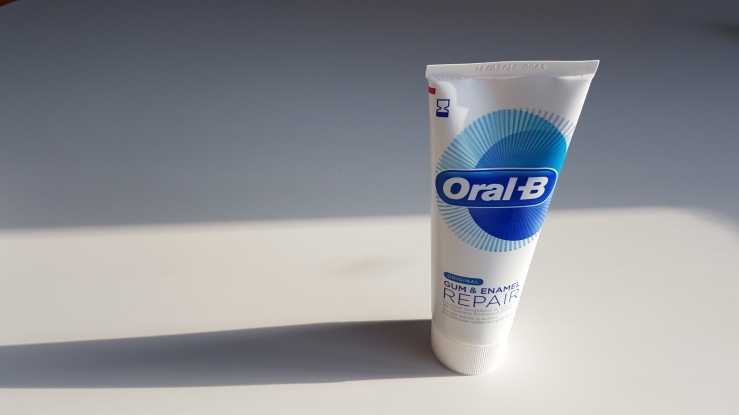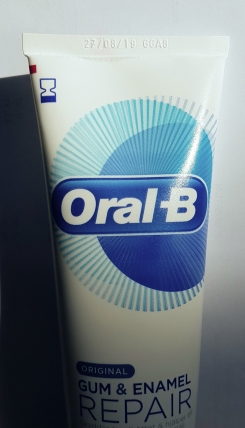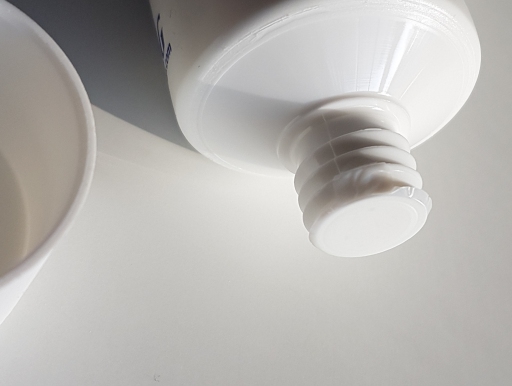
Today I am going to review a toothpaste for the first time ever. It is a toothpaste that was given to me by a representative of Oral-b. It is called Oral-b Gum & Enamel Repair Original toothpaste and it is Oral-b’s newest toothpaste.
Here’s the manufacturer’s selling speech about the toothpaste on their website:
- It defends against acid erosion and helps to repair enamel
- It provides antibacterial action to help rejuvenate gums
- For sensitive teeth – clinically proven
- Oral-B Gum & Repair Original toothpaste comes with a mild flavour and a smooth texture
The Design

The design of the packaging looks simplified and minimalistic which I very much like. This is welcome change from their previous toothpastes’ outlook that had too much information in a small space.
The tube is still easy to open, but there is small change in the lid. It used to be made of metal which at least in my opinion is better recycling-wise than plastic. Small detail but still. Can’t help this image of whales’ intestines full of plastic popping in my mind. But then again the whole tube is plastic.

The Testing
Staying on the environmental subject. The plastic and the whales. There has been lots of talk over microbeads that are found in many consumer products. Even in toothpastes. These microbeads will eventually find their way into the sea and cause problems to the oceans as persistent pollutant. The representative who gave me this Gum & Enamel Repair Original toothpaste sample promised that there are no microbeads in it. The ingredient to look for is polyethylene when you want to make sure there is none of them. I found no polyethylene in the ingredients list (see at the end of this post). Great.
The texture of the toothpaste looks smooth as they promised but when you take closer look, it is not that smooth after all and the fear of microbeads is getting stronger again.

The texture of the Gum & Enamel Repair Original toothpaste

Closer look of the toothpaste reveals tiny beads.
The tiny granules are clearly visible but these could be actually hydrated silica (abrasive), not microbeads.
Ok, time to add toothpaste to my toothbrush. Like with Oral-b Pro-Expert toothpaste, this new one is also quite runny and can be messy if you are not quick enough. Once I had applied toothpaste to my toothbrush I was in a rush to take a photo before it dripped on to the table.

I use my beloved Philips Sonicare
and with this brush the runny texture is actually better than the ones that are stiffer pastes. But I can see that the sink in the bathroom will have toothpaste marks here and there. Also, note to myself – do not let husband use this toothpaste as he brushes his teeth after he has put his suit on. Silly man.
So lets put the toothpaste in my mouth. It does begin to formulate foam which means there is soap in the toothpaste. Not the best option for somebody with sensitive soft tissues or dry mouth. Soap aka sodium lauryl sulfate can make the mouth dry and also it has been linked to canker sores aka aphthous ulcers (although nothing is scientifically proven and oh boy don’t I hear it from the rep e-v-e-r-y time).
Very soon I begin to feel burning sensation on first third of the tongue (the tip of the tongue), both top and bottom of the tongue. Also the tongue feels slightly numb. This carries on all through the brushing and after spitting the toothpaste out. Now, I do advise my patients not to rinse after brushing but the burning sensation is so strong that I must rinse lightly. Once I did that and bit my teeth together, I could feel biting on some grit. This made me think about the abrasiveness of the toothpaste. It is new toothpaste so the RDA value (Relative Dentine Abrasivity) was impossible to find. I will add the RDA value as soon I find it out.
Ten minutes after brushing the burning can still be felt. Also I feel that the layer of skin inside my lips is peeling off. This has been “a feature” with Oral-b Pro-Expert toothpastes and the reps have said it’s absolutely normal and will diminish when using the toothpaste for longer period of time. My colleague asked the rep if this new Gum & Enamel Repair Original toothpaste does the same. I must say that I cannot remember the rep’s exact answer but I think she said this toothpaste should cause less of the peeling of the mucosa. Well it doesn’t. At least with me. If anything I think the peeling of the mucosa is quicker than with Pro-Expert toothpaste.
Twenty minutes after brushing I can still feel the burning feeling slightly. I guess some people will associate this burning feeling with effectiveness of the toothpaste. The more it burns, the more effective it is. As a dental professional I must say that this is not true. No toothpaste should feel uncomfortable to use.
Would I Recommend?
To be honest, most likely I will not recommend this toothpaste to anyone. Not after I took a closer look at the ingredients. One ingredient has been nominated as Allergen of the Year for 2018 by American Contact Dermatitis Society. This ingredient is called propylene glycol.
The list of ingredients is long and to my mind the longer the list is the more side-effects there will be. My favourite toothpaste that I recommend to my patients a lot has only eight ingredients (aqua, crystalline sorbitol, hydrated silica, crystalline xylitol, PEG, anhydrous natural betaine, cellulose gum, sodium fluoride (1500 ppm F), sorbate). Oral-b Gum & Enamel Repair Original toothpaste has nineteen! Three of these ingredients can have adverse reactions to one’s health – propylene glycol, CI 77891 and sodium lauryl sulfate.
Also the fact that I got this burning feeling in my mouth tells me this toothpaste is not suitable for most of the people. Remember that it should not feel unpleasant to use a toothpaste. Certainly it should not hurt. So change if it does.
The Ingredients
Here are the ingredients of the Oral-B Gum & Enamel Repair Original toothpaste and short explanation of what they are (by clicking the link you will find more information):
- Glycerin – an organic compound most commonly from animal fat and vegetable oil
- Hydrated Silica – abrasive
- Sodium Hexametaphosphate – anti-stains and anti-tartar
- PEG-6 – The abbreviation PEG = polyethylene glycol. Possibility for adverse reaction. An emulsifier and foaming agent
- Propylene Glycol – the American Contact Dermatitis Society’s Allergen of the Year for 2018. An emollient and emulsifier.
- Aqua – the main carrier for all ingredients. Helps dissolve other soluble ingredients. Helps the mechanical process of cleaning teeth in mouthwashes
- Zinc Lactate – such a difficult ingredient to find any information solely on zinc lactate. Lots of information on zinc but there must be difference in different types of zinc? If anyone finds trustworthy site with information on zinc lactate, please drop me a line.
- Sodium Gluconate – to sequester calcium and helps to prevent gingivitis
- CI 77891 – titanium dioxide (nanoparticles). A thickening agent and colourant.
- Sodium Lauryl Sulfate – soap, the foaming agent. Can work as an irritant.
- Silica – a mild abrasive to clean teeth.
- Aroma – a chemical compound which adds odours to dental products.
- Sodium Saccharin – an artificial sweetener
- Carrageenan – an extract from a red seaweed. Binds and gels all the ingredients together
- Trisodium Phosphate – stain remover and de-greaser
- Stannous Fluoride – the good in the toothpaste
- Stannous Chloride – antibacterial
- Xanthan Gum – a thickening agent
- Sodium Fluoride – the good in the toothpaste
If you are interested in other common ingredients in toothpastes that can cause adverse reactions, click here.
Edit 21.6.2018
Want to know what the rep told me about the RDA level of the Oral-B Gum & Enamel Repair Original toothpaste? Click here to find out.
You might also like
RDA Value in Toothpastes – Any Relevance?
GC Tooth Mousse Review and Advice for Use
Hands up Who Knew That Zinc in Toothpaste Can Cause Dry Mouth?
Testing Oral-b Smart Phone Holder, Take 1
Testing Oral-b Smart Phone Holder, Take 2



